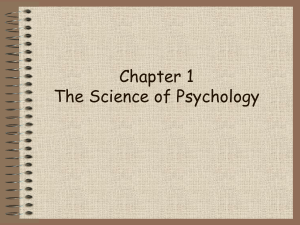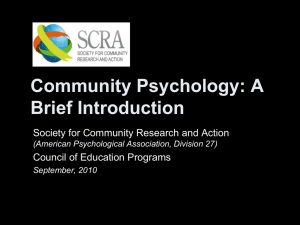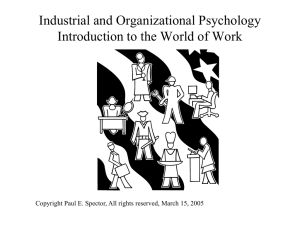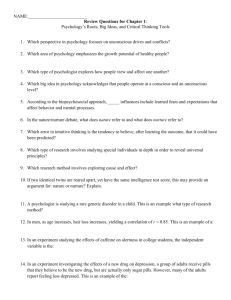File - Thrive in AP Psychology
advertisement
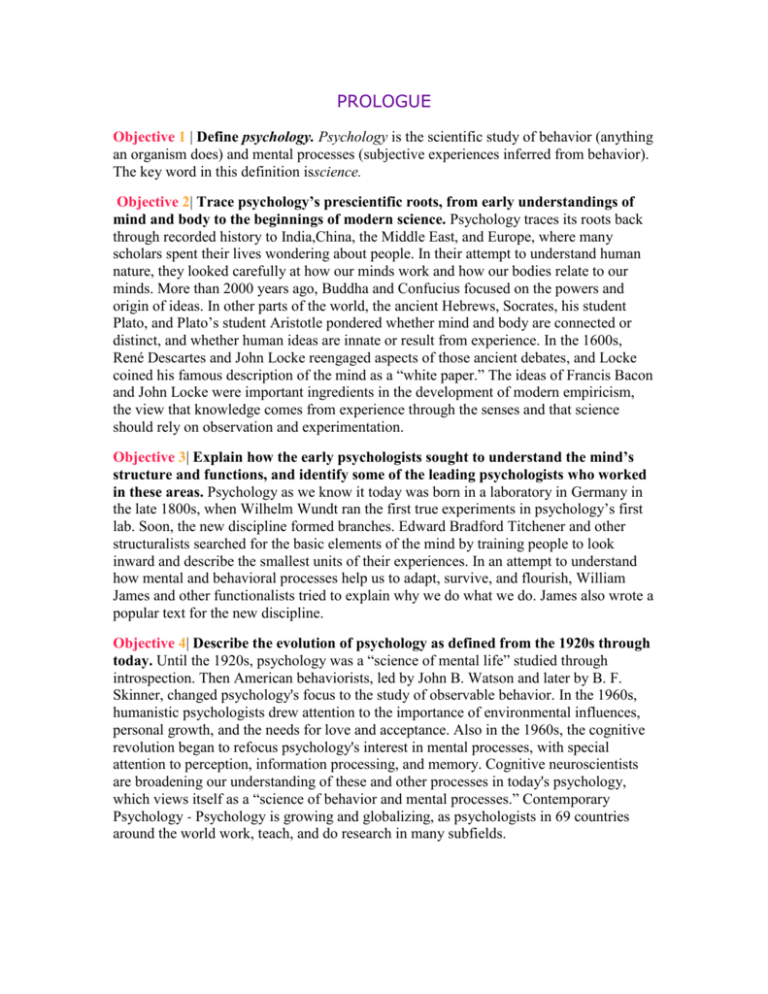
PROLOGUE Objective 1 | Define psychology. Psychology is the scientific study of behavior (anything an organism does) and mental processes (subjective experiences inferred from behavior). The key word in this definition isscience. Objective 2| Trace psychology’s prescientific roots, from early understandings of mind and body to the beginnings of modern science. Psychology traces its roots back through recorded history to India,China, the Middle East, and Europe, where many scholars spent their lives wondering about people. In their attempt to understand human nature, they looked carefully at how our minds work and how our bodies relate to our minds. More than 2000 years ago, Buddha and Confucius focused on the powers and origin of ideas. In other parts of the world, the ancient Hebrews, Socrates, his student Plato, and Plato’s student Aristotle pondered whether mind and body are connected or distinct, and whether human ideas are innate or result from experience. In the 1600s, René Descartes and John Locke reengaged aspects of those ancient debates, and Locke coined his famous description of the mind as a “white paper.” The ideas of Francis Bacon and John Locke were important ingredients in the development of modern empiricism, the view that knowledge comes from experience through the senses and that science should rely on observation and experimentation. Objective 3| Explain how the early psychologists sought to understand the mind’s structure and functions, and identify some of the leading psychologists who worked in these areas. Psychology as we know it today was born in a laboratory in Germany in the late 1800s, when Wilhelm Wundt ran the first true experiments in psychology’s first lab. Soon, the new discipline formed branches. Edward Bradford Titchener and other structuralists searched for the basic elements of the mind by training people to look inward and describe the smallest units of their experiences. In an attempt to understand how mental and behavioral processes help us to adapt, survive, and flourish, William James and other functionalists tried to explain why we do what we do. James also wrote a popular text for the new discipline. Objective 4| Describe the evolution of psychology as defined from the 1920s through today. Until the 1920s, psychology was a “science of mental life” studied through introspection. Then American behaviorists, led by John B. Watson and later by B. F. Skinner, changed psychology's focus to the study of observable behavior. In the 1960s, humanistic psychologists drew attention to the importance of environmental influences, personal growth, and the needs for love and acceptance. Also in the 1960s, the cognitive revolution began to refocus psychology's interest in mental processes, with special attention to perception, information processing, and memory. Cognitive neuroscientists are broadening our understanding of these and other processes in today's psychology, which views itself as a “science of behavior and mental processes.” Contemporary Psychology - Psychology is growing and globalizing, as psychologists in 69 countries around the world work, teach, and do research in many subfields. Objective 5| Summarize the nature-nurture debate in psychology, and describe the principle of natural selection. Psychology’s biggest and most enduring issue concerns the balance between the influences of nature (genes) and nurture (all other influences, from conception to death). Philosophers had long debated whether nature (the view of Plato and Descartes) or nurture (the view of Aristotle and Locke) was more important. Charles Darwin proposed a mechanism—the principle of natural selection—by which nature selects chance variations that enable organisms to survive and reproduce in particular environments. Psychologists now believe that in most cases, every psychological event is simultaneously a biological event. A great deal of research, including studies of identical and fraternal twins, sheds light on the relative importance of these two sets of influences on such traits as personality and intelligence. Objective 6| Identify the three main levels of analysis in the biopsychosocial approach, and explain why psychology's varied perspectives are complementary. The biopsychosocial approach integrates information from the biological, psychological, and social-cultural levels of analysis. Psychologists study human behaviors and mental processes from many different perspectives (including the neuroscientific, evolutionary, behavior genetics, psychodynamic, behavioral, cognitive, and social-cultural perspectives). Melding the information gathered from these many lines of research creates a more complete understanding of behaviors and mental processes than would be available from any one viewpoint alone. Objective 7| Identify some of psychology’s subfields, and explain the difference between clinical psychology and psychiatry. Psychology’s subfields encompass basic research (often done by biological, developmental, cognitive, personality, and social psychologists), applied research (sometimes conducted by industrial/organizational psychologists), and clinical applications (the work of counseling and clinical psychologists). Clinical psychologists study, assess, and treat (with psychotherapy) people with psychological disorders; psychiatrists also study, assess, and treat people with disorders, but they are medical doctors who can prescribe medication as well as offer psychotherapy. Objective 8| State five effective study techniques. (1) Distribute study time. (2) Listen actively in class. (3) Overlearn. (4) Focus on big ideas. (5) Be a smart test-taker.

